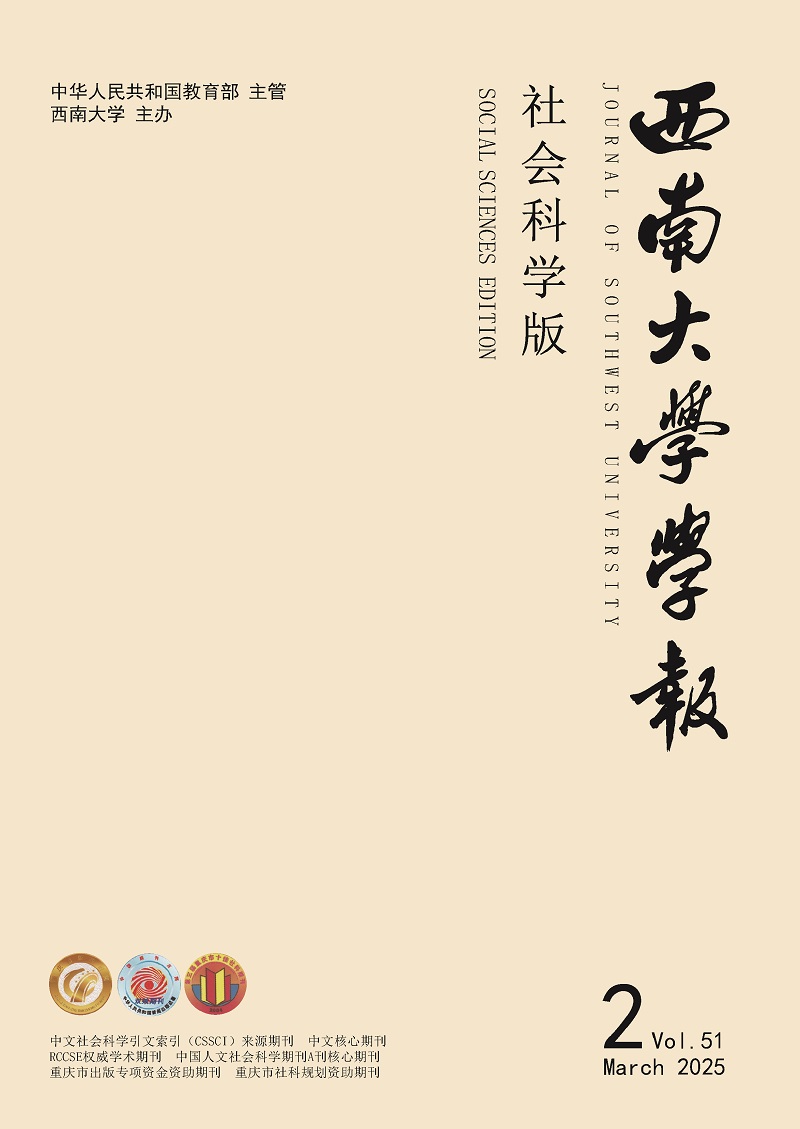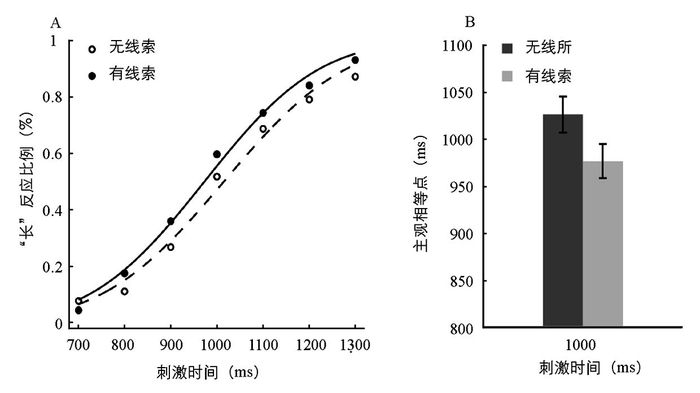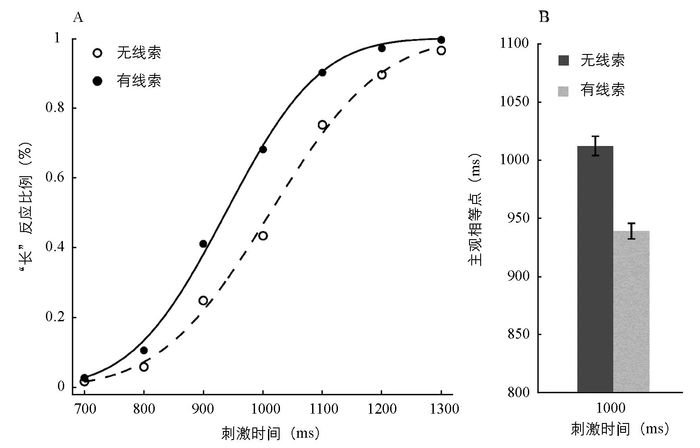HTML
-
时间知觉是对客观现象持续性和顺序性的感知,是运动控制、语音识别和音乐欣赏等活动的必要条件,也是人们有效安排日常生活和工作的前提[1-2]。在日常的生活中,物理时间和我们的主观时间通常是不一致的,会受到个体的唤醒状态、知识经验、刺激属性等因素的影响。比如快乐的时光总是一瞬而逝,等待却显得特别漫长[3-4]。体积较大或者比较复杂的刺激会扩展我们的主观时间,而重复出现或高概率出现的刺激会压缩我们的主观时间[5-6]。那么,如何解释物理时间和主观时间之间的差异及其影响因素呢?虽然目前研究中存在许多争论,但多数研究认为注意和唤醒是影响主客观时间知觉不一致的关键因素[7-11]。
注意可以区分为选择性注意和非选择性警觉注意:选择性注意主要包含注意的集中和注意资源的分配,而非选择性注意主要代表注意的强度(例如,警觉和持续性注意)[12-15]。在以往关于注意对时间知觉的研究中,研究者主要关注了选择性注意对时间知觉的影响[10, 16-18]。选择性注意在解释时间知觉的理论模型中也占据着重要的位置,以时钟模型理论为基础的标量预期理论(scalar expectancy theory,SET)认为时间信息加工过程包括时钟、记忆和决策三个水平。时钟阶段通过起搏器以一定的频率产生脉冲,在起搏器和累加器之间有一开关,选择性注意决定着这个开关的闭合,当注意时间特征时,开关闭合,脉冲通过开关进入累加器进行累加。记忆阶段由工作记忆和参照记忆组成,累加器把有关的时间信息传送至工作记忆和参照记忆中,并形成相应的时间表征。决策阶段主要对工作记忆中的当前时距和参照记忆中的时距表征进行比较,进而做出判断[19-21]。根据标量预期模型,当人们把注意资源越多地分配到信息时间的特征上,起搏器的脉冲就会越多的传输到累加器中,人们知觉到的时间就越长;相反,减少对时间特征的注意,人们知觉到的时间就会变短[10, 22, 23]。虽然,有大量的研究考察选择性注意对时间知觉研究的影响,但很少有研究关注非选择性警觉注意是否会影响以及如何影响时间知觉的问题。
警觉作为一种非选择性注意,它是个体对没有出现但可能出现的刺激的一种持续性的准备状态,特指外源性警觉(phasic alertness),不同于一般意义上的唤醒状态(内源性警觉,tonic alertness),是选择性注意的基础[14, 24, 25]。一般用信号提示线索范式来研究外源性警觉,具体指在目标刺激出现之前呈现一个警觉提示信号,警觉提示信号和目标刺激之间的时间间隔是随机的,且不提示目标刺激出现的位置,有警觉信号和无警觉信号的目标刺激的反应时之间的差值代表了警觉的效率。差值越大,表示被试的外源性警觉水平越高;相反,被试的外源性警觉效率就越低[13, 26]。在日常工作中,有很多的工作岗位需要作业者保持较高的警觉效率和准确的时间知觉,比如机场调度人员、宇航飞行员、汽车司机和执行特殊任务的军人等,若此类的工作中,作业者因为警觉水平下降或者时间知觉出现偏差而导致操作不当或者延误时机,则可能造成巨大的人员伤亡和财产损失。警觉能力也是在选拔运动员、飞行员和汽车司机的重要参考指标[27-30]。因此,警觉和时间知觉在人们的日常生活和工作中,都具有重要意义。
那么,警觉是否会影响时间知觉,以及如何影响时间知觉呢?在日常的生活中,会经常遇到警觉影响时间知觉的情景,例如,我们在等待重要、紧急事情的时候,个体警觉提高,感觉时间流逝变慢,主观时间变长,个体高估时间。Droit-Volet[31]发现如果在时间刺激之间呈现一个听觉提示信号(提示信号会提高被试的警觉水平),儿童会高估时间。因此,我们假设警觉会影响时间知觉。此外,不同通道的时间知觉信息加工,存在不对称现象,例如听觉刺激会影响视时间知觉,而视觉刺激不会影响听时间知觉[32, 33]。研究也发现听觉通道的时间信息加工比视觉通道的信息加工更加敏感[34-39],视听时间知觉的神经机制也存在一定的差异[7],那么,警觉对不同通道的信息加工影响是否相同呢?我们通过两个实验对这一问题进行研究,实验一采用听觉信号提示线索和视觉通道内的时间二分法相结合的范式来探索警觉对视觉通道内的时间知觉的影响。实验二采用听觉信号提示线索和听觉通道内的时间比较法相结合的范式来探讨警觉对听觉时间信息加工过程的影响。通过两个实验我们来探讨警觉怎样影响时间知觉,以及警觉对视听通道的时间信息加工是否相同。
-
25个被试(23个女生,年龄在18~25岁,平均年龄21岁)。所有被试均报告视力或矫正视力正常,无色盲或色弱,右利手。实验后被试均获得适量的实验报酬。
-
程序采用E-prime编制,刺激呈现在17英寸彩色显示器上,屏幕分辨率为1 024×768pixels,刷新率为85Hz。被试眼睛距离屏幕中心约50cm。时间刺激白色正方形,大小为135pixels×135pixels,屏幕背景为黑色。听觉提示线索为300ms的纯音(采样率44.1Khz,频率为440hz,响度为50dB,波形为正弦波)。
-
实验采用信号提示线索范式和二分法相结合的范式。实验分为学习阶段和测验阶段。在学习阶段,被试首先学习“长”标准刺激(1 300ms)和“短”标准刺激(700ms)各5次。在测验阶段,7个时间段(700ms,800 ms,900ms,1 000ms,1 100ms,1 200ms and 1 300ms)随机呈现。被试的任务是判断测验阶段呈现的时间段是更接近“长”标准时间,还是更接近“短”标准时间,如果呈现的标准时间更接近“长”标准时间,被试就用右手食指按“K”键。。如果呈现的时间更接近“短”标准时间,被试就用左手食指按“D”键。按键在被试间平衡。在时间刺激出现之前,在50%试次中,双耳中会呈现一个300ms的纯音提示线索,50%试次没有提示线索。在有提示线索的试次中,首先在屏幕中央呈现注视点“+”号1 000ms,接着双耳中呈现纯音提示线索300ms,随后随机出现(450ms、650ms或850ms)的空屏。接着出现白色正方形,白色正方形从出现到消失的时间为比较时间。白色正方形消失后,屏幕中央会出现一个问号。被试的任务是判断在问号出现的时候,判断比较时间是更接近“长”标准时间,还是更接近“短”标准时间。反应结束后,随机呈现1 500~2 500ms的时间段。实验过程中,除了线索、白色正方形和问号呈现的时间外,屏幕中央一直出现“+”号注视点。在没有线索的试次中,除了没有纯音提示线索,其它和有提示线索的试次流程完全相同。每种条件共出现16次,共224试次。
-
计算每种条件下的每一个时间段(t)做“长”反应的比例P(“长”|t)。根据每个时间段的P(“长”|t),通过累加高斯函数拟合出一条S形曲线。拟合用的两个参数分别是平均数(μ)和标准差(σ)。平均数为被试的主观相等点(Point of Subjective Equality,PSE),即当P(“长”|t=μ)=0.5时所对应的时间段。标准差(σ)则和被试的时间知觉的敏感性有关(标准差越小,时间知觉的差别阈限越小,被试的时间敏感性就越高)。估计参数(μ,σ)和判定系数(coefficient of determination,R2)的描述性统计如表 1。
为了探讨有警觉提示线索和无警觉提示线索条件下被试在时间知觉上的差异,作者比较了两种条件下的时间知觉拟合函数的估计参数(μ,σ)和可解释变异量(R2)之间的差异。对于两种条件下的时间知觉的拟合曲线的判定系数(R2)的方差分析显示两种条件下被试之间的差异不显著(F(1,24)=3.72,p>0.05,ηp2=0.13),说明两种条件下被试时间知觉拟合曲线的拟合优度上没有显著差异。对表示时间知觉敏感性的标准差(σ)方差分析显示两种条件下的标准差差异不显著(F(1,24)=2.06,p>0.1,ηp2=0.08)(图 1A),说明两种条件下在时间知觉的敏感性方面没有差异。对于两种条件下被试的主观相等点(μ),方差分析显示两种条件下被试的主观相等点差异显著(F(1,24)=17.42,p<0.01,ηp2=0.42)(图 1B)。
以上结果说明,两种条件下的被试在时间知觉的敏感性上没有差异,在主观相等点上存在差异,有声音信号提示条件下被试倾向高估时间,而无声音信号提示条件下被试倾向低估时间。
实验一的结果说明,警觉信号会影响视时间知觉。有警觉信号的条件下,被试倾向高估视时间,没有警觉信号提示的条件下,被试倾向低估视时间,而视时间知觉的敏感性在这两种条件下没有差异。然而,听时间知觉相对于视时间知觉加工更加敏感[34-37]。那么,警觉信号是否会影响听时间知觉的敏感性呢?还是只影响时间知觉估计的长短呢?在实验二中,我们通过结合警觉提示线索和时间比较法来研究警觉提示信号对听时间信息加工的影响。
一. 被试
二. 仪器和材料
三. 实验设计与程序
四. 结果与分析
-
30个被试(27个女生,年龄在18~24岁,平均年龄21岁)。所有被试均报告视力或矫正视力正常,无色盲或色弱,右利手。实验后被试均获得适量的实验报酬。
-
实验二中,用到两种不同频率的纯音材料。持续300ms的听觉提示纯音(采样率44.1Khz,频率为440hz,响度为50dB,波形为正弦波)和标记时间的七个时间段的声音刺激700ms,800ms,900ms,1 000ms,1 100ms,1 200ms和1 300ms(采样率44.1Khz,频率为220hz,响度为50dB,波形为正弦波),其它实验仪器和材料同实验一。
-
实验采用被试内设计。除了标记时间的视觉刺激改为听觉刺激,屏幕中央一直呈现注视点,其它实验程序和实验器材同实验1。
-
和实验一的计算方式相同,计算每种条件下的每一个时间段(t)做“长”反应的比例P(“长”|t)。根据每个时间段的P(“长”|t),通过累加高斯函数拟合出一条S形曲线。拟合用的两个参数分别是平均数(μ)和标准差(σ)。平均数为被试的主观相等点(Point of Subjective Equality,PSE),也就是当P(“长”|t=μ)=0.5时所对应的时间段。标准差(σ)则和被试的时间知觉的敏感性有关(标准差越小,时间知觉的差别阈限越小,被试的时间敏感性就越高),估计参数(μ,σ)和判定系数(coefficient of determination, R2)的描述性统计如表 2。
为探讨不同线索提示条件下被试在时间知觉上的差异,作者比较了两种条件下的时间知觉拟合函数的估计参数(μ,σ)和判定系数(R2)之间的差异。对于判定系数(R2),方差分析显示线索提示的主效应不显著(F<1),说明不同条件下拟合曲线的拟合优度不存在差异。对于表示时间知觉敏感性的标准差(σ),方差分析显示线索提示的主效应显著(F(1,29)=5.94,p<0.05,ηp2=0.17),说明两种条件下被试在时间知觉敏感性上存在差异(图 2A),即有提示线索相对于无提示线索可以改善被试的时间敏感性。对于不同条件下的被试的主观相等点(μ),方差分析显示线索的主效应显著(F(1,29)=87.38,p<0.001,ηp2=0.75)。说明主观相等点在无提示线索和有提示线索两种条件下差异十分显著(图 2B)。实验二的结果说明在听觉通道内,警觉提示线索不但可以使被试对时间知觉的主观相等点显著左移从而高估时间,也可以显著改善被试时间知觉的敏感性。
一. 被试
二. 仪器和材料
三. 实验设计与程序
四. 结果与分析
-
两个实验中,警觉信号都可以使被试高估时间,但对时间敏感性的影响却不同:警觉信号对被试视时间知觉的敏感性没有影响,却可以提高被试听时间知觉的敏感性。警觉信号使个体时间知觉的主观相等点左移,高估时间,改善听时间知觉的敏感性,这一作用对于人们适应复杂的环境具有重要的意义。比如,在危险的情景中提前释放预警信号,个体警觉水平提高,感觉时间流逝变慢,个体相对就会有较多的时间来应对危险的情况[40-41]。因此,探讨警觉对时间知觉的影响及其认知机制具有重要的现实意义。此外,在关于时间知觉的实验研究和理论解释中,已有的研究主要关注了选择性注意在其中的作用[10, 16, 18, 42],却忽略了持续性警觉注意在时间信息加工过程中的作用。因此,探讨警觉在时间信息加工过程中的作用,对于发展和完善已有的时间知觉理论也具有重要的价值。
在标量预期模型的框架内,时间信息加工过程中,高估时间的原因有两种:一是选择性注意的影响,选择性注意可以调节时间信息加工过程中起搏器和累加器之间的开关开合的潜伏期。当注意时间信息特征时,起搏器和累加器之间的开关闭合;当结束对时间信息特征的注意时,起搏器和累加器之间的开关打开。不论物理时间的长短,开关开合的潜伏期对于估计时间长短的影响是相同的,是一种加法的性质。二是唤醒的影响,唤醒可以调节起搏器的脉冲速率,唤醒水平越高,起搏器的脉冲速率就越快,物理时间越长,被试对时间的高估就会越多,同时会增加被试时间知觉的敏感性,表现出乘法的性质[43-44]。
先前研究指出,警觉信号会周期性地提高个体的唤醒水平[45-46],警觉是选择性注意的基础[24-25],因此警觉信号可能会同时通过调节注意和唤醒影响时间知觉。实验一的结果显示警觉信号使被试的主观相等点左移,高估视时间,但视时间知觉的敏感性不变,说明不论物理时间的长短,被试对视时间高估的量是相同的,警觉信号可能通过调节对视时间信息特征的选择性注意来实现[43-44]。在实验一中,相对于没有提示线索的条件,警觉提示线索的出现使被试的警觉水平提高,当标记时间的物理刺激出现时,被试可以更容易的注意到物理刺激的时间属性,起搏器和累加器之间的开关就会提前闭合,即开关的潜伏期缩短,被试就倾向高估时间,但不影响视时间知觉的敏感性。实验二的结果显示警觉信号不但使被试高估时间,也提高了被试时间知觉的敏感性,说明警觉信号可能是通过调节个体的唤醒水平影响时间知觉的[43-44]。在实验二中,警觉信号的出现提高了个体的唤醒水平,从而使起搏器的脉冲速率变快,被试高估时间,且物理时间越长,个体对时间的高估就会越多,进而影响被试时间知觉的敏感性。虽然,在实验二中警觉信号既影响了听时间知觉的长短,也影响了听时间知觉的敏感性,但并不能说明警觉仅仅是通过调节唤醒水平来影响听时间知觉的,也存在警觉通过对选择性注意的调节影响起搏器和累加器之间开关开合的潜伏期,两者并不矛盾,这两种调节同时存在时也会导致实验二结果的产生,实验一的结果也说明警觉可以通过影响开关开合的潜伏期影响时间知觉。因此,在听觉通道内,警觉信号可能是通过对选择性注意和唤醒的双重影响来实现的。
实验一和实验二不同的结果说明警觉信号对视时间知觉和听时间知觉的影响是不同的。先前的研究发现视时间知觉和听时间知觉不同,听觉通道对时间信息加工更加敏感[34, 47],听觉刺激也更加容易捕获和保持注意,是一种相对自动化的注意过程[48-50]。因此,造成警觉信号对视听时间知觉影响不同的原因可能是因为听觉时间编码的起搏器更容易受到警觉信号的影响,而视觉时间信息加工的起搏器节律则不易受到警觉信号的影响。警觉信号会引起短暂的唤醒,这种唤醒能够影响听觉通道起搏器的节律,却不足以达到影响视觉通道起搏器节律的强度。这一结果也说明视听通道内的时间知觉的编码阶段的机制可能是不同的,时间信息的加工是分布式而不是集中式的,至少不同通道的时间知觉编码阶段的机制是分布式的[7, 51-52]。
警觉对时间知觉的影响是通过调节唤醒还是选择性注意的这一点争论也同样存在于情绪对时间知觉的影响中[8, 31, 53-54]。例如,Grommet等人[54]发现由图片所诱发的恐惧情绪会使被试高估时间,但不影响时间知觉的敏感性,表现出加法的性质,其认为恐惧情绪对时间知觉的影响可能是通过调节注意来改变开关的潜伏期实现的。Droit-Volet等人[55]发现由电影所诱发的恐惧情绪不但使被试高估时间,提高了被试时间知觉的敏感性,他们认为恐惧情绪对时间知觉的影响是通过唤醒引起的,影响的是起搏器的脉冲速率。先前的研究指出恐惧性信息会提高被试的警觉水平和唤醒度[56-57]。那么,为什么同样的恐惧情绪对时间的知觉影响却不同呢?根据当前的研究结果,我们推测由图片和电影所诱发的恐惧情绪所引起的警觉和唤醒的强度不同,相对于图片,由恐怖电影诱发的恐惧情绪所引起的警觉水平和唤醒度更高,从而更容易影响时间知觉中起搏器的速率和开关的潜伏期。因此,情绪对时间知觉的影响也可能是通过对警觉的影响,进而调节注意和唤醒双重因素来实现的。因此,探讨警觉影响时间知觉的机制,对于解决情绪对时间知觉影响的研究中存在的矛盾有很好的参考价值。
-
实验一的结果说明警觉对视时间知觉的影响可能是通过改变开关的潜伏期实现的。而实验二的结果说明警觉对听时间知觉的影响则可能是通过改变开关的潜伏期和起搏器的节律实现的。这一结果说明视听通道的时间信息加工机制可能是不同的,对解决情绪影响时间研究中存在的争论也有一定的参考价值。更加重要的是,以往的研究认为选择性注意在时间知觉中起着重要的作用,却忽视了警觉在时间知觉中的作用,本研究发现警觉可能在时间知觉中起着更加基础的作用,通过调节选择性注意和唤醒来影响时间知觉,这一发现对于发展和完善已有的时间知觉理论模型有重要的意义,未来需要进一步探讨警觉影响时间知觉的神经生物学基础。








 DownLoad:
DownLoad: